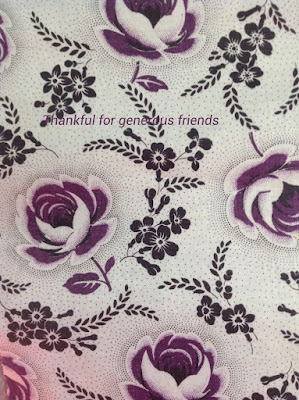Thanks to a wonderful dear friend I came home my Netherlands trip with more treasured Dutch fabrics to add to my collection.
The detail in the flowers is wonderful with the fine picotage dots. Imagine wearing this!
In traditional Dutch costumes several prints and plaids are used. There are many regional variations to the traditional dress and head covers. You can see Staphorst from my trip last year HERE.
The use of a variety of fabrics and styles serves to tell a little story to a knowledgeable observer. Just like today what we wear to a party is generally different then what we wear doing daily errands.
These dark purples prints are traditional regional mourning prints. The darker the print, the deeper the mourning. The wearer was closer to the deceased, where a light purple indicates the mourning for a person less close to the wearer. I am sure there are variations on this based on region and era.
The button is the sign of Zeeland. Which means "sea land". This region of the Netherlands consists of a series of small islands with a strip of land that borders Belgium. Zealand Buttons have a special design. HERE.
These fabrics are from Bunschoten/Spakenburg in Noord-Holland.
Many here still wear the local garments. I might have the purple print in the wrong stack - it might be light mourning.
These fabrics are used in several parts of the outfit.
These prints are from circa 1960 and many of the pieces were cut from cast off garments.
To put the prints in context, another friend gave me an issue of Het Klossie magazine with an article.
Note the prints at the shoulder.
The fabric here is heavily starched so-called "kraplappen".
A little more research and I found this You Tube video that shows you the starching prices. It is not in English, but worth watching. I am particularly interested in the second iron and the way she uses the heel feature at the end of the iron. HERE
The fabrics are also used for the "baffles" which is the flat part of the bodice. Also, sometimes the upper portion of the skirt.
Thank you to my friends who made the 2017 Netherlands trip a success - fun and informative!
I hope to return one day soon.Happy Stitching,
Dawn
LINKS
The detail in the flowers is wonderful with the fine picotage dots. Imagine wearing this!
In traditional Dutch costumes several prints and plaids are used. There are many regional variations to the traditional dress and head covers. You can see Staphorst from my trip last year HERE.
The use of a variety of fabrics and styles serves to tell a little story to a knowledgeable observer. Just like today what we wear to a party is generally different then what we wear doing daily errands.
 |
| c. 1960 from old garments |
The button is the sign of Zeeland. Which means "sea land". This region of the Netherlands consists of a series of small islands with a strip of land that borders Belgium. Zealand Buttons have a special design. HERE.
These fabrics are from Bunschoten/Spakenburg in Noord-Holland.
These fabrics are used in several parts of the outfit.
These prints are from circa 1960 and many of the pieces were cut from cast off garments.
 |
| Fotografie: Folkert Koelewijn Het Klossie Magazine |
To put the prints in context, another friend gave me an issue of Het Klossie magazine with an article.
Note the prints at the shoulder.
The fabric here is heavily starched so-called "kraplappen".
A little more research and I found this You Tube video that shows you the starching prices. It is not in English, but worth watching. I am particularly interested in the second iron and the way she uses the heel feature at the end of the iron. HERE
The fabrics are also used for the "baffles" which is the flat part of the bodice. Also, sometimes the upper portion of the skirt.
 |
| In this view you can see the back of the bonnet, the waist faster and the back of the bodice. |
 |
| Another view showing the beautiful fabrics! |
 |
| NOTE: I added the words of thanks to the image - they are not part of the fabric |
Thank you to my friends who made the 2017 Netherlands trip a success - fun and informative!
I hope to return one day soon.Happy Stitching,
Dawn
LINKS
Museum Spakenburg HERE
Spakenburg Museum Exhibit Details HERE
Museum Gift Shop Photos HERE
Het Klossie Quilt Magazine HERE
Dutch Fabrics HERE






































